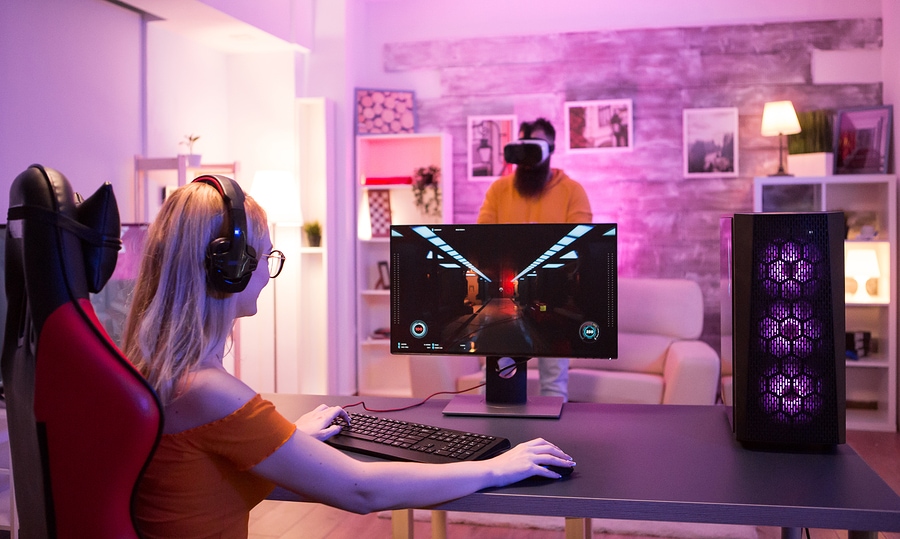If you’re just beginning to build your gaming PC or are looking for the final piece in the puzzle, choosing the right gaming monitor is never an easy choice.
Investing in a decent graphics card and a powerful processor may be your main priority, but when it comes to the monitor the last thing you want is for all that performance to go to waste on a sub-par display.
If you want to truly experience your games the way they’re supposed to be, you’ve got a lot of different monitors to choose from with a few key points to take into consideration. It’s almost a daunting task but this article aims to help you choose the right gaming monitor for you.
Check The Monitor’s Refresh Rate
One of the first things to look out for when choosing a monitor is the refresh rate. The refresh rate is the number of times a monitor refreshes the image on the screen. The higher the refresh rate, the smoother the image will appear and the more responsive your games will feel.
This is vital for those who engage in competitive gaming. Fast-paced titles such as first-person shooters will require a smooth gaming experience to ensure there’s no lag.
Refresh rates tend to range from 60 Hz to 240 Hz so it might be worth investing in a better refresh rate if you’re going to be playing a lot of fast-paced action titles.
Panel Type
Monitors have two different panel types, TN and IPS. TN or Twisted Nematic designs are the most common panel types you’ll find and are the least expensive option.
TN monitors now tend to have ultrafast response times such as 1ms to 2ms. However, they are often let down by the pixel density, colour quality and viewing angles.
IPS or In-Plane-Switching monitors, on the other hand, use polarized filters and liquid crystals to improve colour visibility and light distortion. They typically offer 8-bit depth per colour rather than the average TN monitor which uses 6-bit.
However, the main downside to IPS panels is that they can be vastly more expensive. Another drawback is that they have poorer response times, usually between 5ms to 8ms.
Response Time
Response time is the time it takes for a pixel to change from fully active, to fully inactive and back again.
Fast response times usually mean better picture quality and less image ghosting as it’s taking less time for the image on the screen to change. This is vital for gaming sessions to ensure that your monitor is keeping up with what’s happening in the game.
Adaptive Sync Technology
If screen tearing is something you’re worried about, Adaptive Sync Technology such as G-Sync or Freesync can come to the rescue. Sync technology syncs the refresh rate of your monitor to the frame rate of the game you’re playing.
This will hopefully fix any screen tearing problems. However, the downside is that it can affect overall performance which is something to watch out for. Luckily, there are plenty of monitor choices when it comes to Adaptive Sync Technology from brands such as Nvidia and AMD. Be careful though, if you choose a FreeSync monitor you’ll need an AMD graphics card in your computer, the same goes if you opt for Nvidia’s G-Sync.
Screen Size
A lot of people make the mistake of assuming a bigger screen is going to equal a better experience. However, as you typically sit closer to a gaming monitor than you do with a TV, it’s best to think carefully before investing in a huge monitor.
Most people opt for a screen between 24 to 27 inches which is ideal if you’re sitting 3 to 4 feet away. This will allow you to clearly see everything all at once which is vital for the competitive gamers out there.
However, if a large monitor is important, you might also want to take a look at widescreen and ultrawide screen monitors. Just make sure you’re not sitting too close to it. You’ll also have to think carefully about whether your CPU and GPU can handle running on a large monitor.
Choosing the Best Gaming Monitor
A lot of this comes down to personal preference but the best starting point is to decide what you really need from a gaming monitor.
If you play a lot of action games, then you will need to prioritise refresh rates and response times to ensure you can maintain your competitive edge. If you are aiming for the best possible picture, you may want to look at higher resolution monitors such as 4K monitors.
Whatever your budget and preferences, it’s important not to overlook the importance of choosing the best gaming monitor for your needs. It can make all the difference to your gaming experiences.
